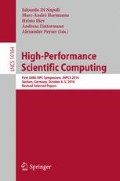Abstract
The reliability of common stress-based power law models for hemolysis estimations in blood pumps is still not satisfying. Stress-based models are based on an instantaneous shear stress measure. Therefore, such models implicitly assume that red blood cells deform immediately due to the action of forces. In contrast, a strain-based model considers the entire deformation history of the cells. By applying a viscoelastic tensor equation for the stress computation, the effect of exposure time is represented as a biophysical phenomenon. Comparisons of stress-based and strain-based hemolysis models in a centrifugal blood pump show very significant differences. Stress peaks with short exposure time contribute to the overall hemolysis in the stress-based model, whereas regions with increased shear and long exposure time are responsible for damage in the strain-based model.
Access this chapter
Tax calculation will be finalised at checkout
Purchases are for personal use only
References
Arora, D., Behr, M., Coronado-Matutti, O., Pasquali, M.: Estimation of hemolysis in centrifugal blood pumps using morphology tensor approach. In: Bathe, K. (ed.) Proceedings of 3rd MIT Conference on Computational Fluid and Solid Dynamics, pp. 578–582. Elsevier Ltd. (2005)
Arora, D., Behr, M., Pasquali, M.: A tensor-based measure for estimating blood damage. Artif. Organs 28, 1002–1015 (2004). errata in Artificial Organs 36(5), 500 (2012)
Arora, D., Behr, M., Pasquali, M.: Hemolysis estimation in a centrifugal blood pump using a tensor-based measure. Artif. Organs 30(7), 539–547 (2006)
Blackshear, P., Blackshear, G.: Mechanical hemolysis. In: Skalak, R., Chien, S. (eds.) Handbook of Bioengineering, p. 15.1–15.19. McGraw-Hill, New York (1987)
Blackshear, P., Dorman, F., Steinbach, J.: Some mechanical effects that influence hemolysis. ASAIO J. 11(1), 112–117 (1965)
Bludszuweit, C.: Three-dimensional numerical prediction of stress loading of blood particles in a centrifugal pump. Artif. Organs 19(7), 590–596 (1995)
Bronkhorst, P., Streekstra, G., Grimbergen, J., Nijhof, E., Sixma, J., Brakenhoff, G.: A new method to study shape recovery of red blood cells using multiple optical trapping. Biophys. J. 69(5), 1666–1673 (1995)
Chien, S.: Shear dependence of effective cell volume as a determinant of blood viscosity. Science 168(3934), 977–979 (1970)
Chien, S.: Red cell deformability and its relevance to blood flow. Annu. Rev. Physiol. 49, 177–192 (1987)
Evans, E., LaCelle, P.: Intrinsic material properties of the erythrocyte membrane indicated by mechanical analysis of deformation. Blood 45, 29–43 (1975)
Farinas, M., Garon, A.: Fast three-dimensional numerical hemolysis approximation. Artif. Organs 28(11), 1016–1025 (2004)
Farinas, M., Garon, A., Lacasse, D., N’dri, D.: Asymptotically consistent numerical approximation of hemolysis. J. Biomed. Eng. 128, 688–696 (2006)
Fischer, T.M.: Shape memory of human red blood cells. Biophys. J. 86, 3304–3313 (2004)
Fischer, T., Stohr-Lissen, M., Schmid-Schönbein, H.: The red cell as a fluid droplet: tank tread-like motion of the human erythrocyte membrane in shear flow. Science 202(4370), 894–896 (1978)
Gesenhues, L., Pauli, L., Behr, M.: Strain-based blood damage estimation for computational design of ventricular assist devices. Int. J. Artif. Organs 39(4), 166–170 (2016)
Giersiepen, M., Wurzinger, L., Opitz, R., Reul, H.: Estimation of shear stress-related blood damage in heart valve prostheses - in vitro comparison of 25 aortic valves. Int. J. Artif. Organs 13(5), 300–306 (1990)
Hénon, S., Lenormand, G., Richert, A., Gallet, F.: A new determination of the shear modulus of the human erythrocyte membrane using optical tweezers. Biophys. J. 76(2), 1145–1151 (1999)
Keller, S., Skalak, R.: Motion of a tank-treading ellipsoidal particle in a shear flow. J. Fluid Mech. 120, 27–47 (1982)
Leverett, L., Hellums, J., Alfrey, C., Lynch, E.: Red blood cell damage by shear stress. Biophys. J. 12, 257–273 (1972)
Maffettone, P., Minale, M.: Equation of change for ellipsoidal drops in viscous flow. J. Non-Newton. Fluid Mech. 78, 227–241 (1998)
Nicoud, F., Toda, H., Cabrit, O., Bose, S., Lee, J.: Using singular values to build a subgrid-scale model for large eddy simulations. Phys. Fluids (1994-present) 23(085106), 1–12 (2011)
Pauli, L., Both, J., Behr, M.: Stabilized finite element method for flows with multiple reference frames. Int. J. Numer. Meth. Fluids 78, 657–669 (2015)
Pauli, L., Nam, J., Pasquali, M., Behr, M.: Transient stress-based and strain-based hemolysis estimation in a simplified blood pump. Int. J. Numer. Meth. Biomed. Eng. 29(10), 1148–1160 (2013)
Probst, M.: Robust Shape Optimization for Incompressible Flow of Shear-Thinning Fluids. Ph.D. thesis, RWTH Aachen University, Aachen, Germany (2013)
Rand, R.: Mechanical properties of the red cell membrane: II. viscoelastic breakdown of the membrane. Biophys. J. 4(4), 303–316 (1964)
Riveros-Moreno, V., Wittenberg, J.: The self-diffusion coefficients of myoglobin and hemoglobin in concentrated solutions. J. Biol. Chem. 247(3), 895–901 (1972)
Schmid-Schönbein, H., Wells, R.: Fluid drop-like transition of erythrocytes under shear. Science 165(3890), 288–291 (1969)
Stewart, S., Hariharan, P.: Computational round robin #2 (model blood pump), October 2013. https://fdacfd.nci.nih.gov/interlab_study_2_blood_pump
Wurzinger, L., Opitz, R., Eckstein, H.: Mechanical blood trauma: an overview. Angeiologie 38, 81–97 (1986)
Zhang, T., Taskin, M., Fang, H., Pampori, A., Jarvik, R., Griffith, B., Wu, Z.: Study of flow-induced hemolysis using novel couette-type blood-shearing devices. Artif. Organs 35(12), 1180–1186 (2011)
Acknowledgments
We like to thank Jaewook Nam and Matteo Pasquali for their contributions to previous implementations of the hemolysis models. In addition, we gratefully acknowledge the support by the DFG program GSC 111 (AICES Graduate School). Computing resources were provided by the RWTH Aachen University IT Center and by the Forschungszentrum Jülich John von Neumann Institute for Computing under the Jülich Aachen Research Alliance (JARA).
Author information
Authors and Affiliations
Corresponding author
Editor information
Editors and Affiliations
Rights and permissions
Copyright information
© 2017 Springer International Publishing AG
About this paper
Cite this paper
Pauli, L., Behr, M. (2017). On the Significance of Exposure Time in Computational Blood Damage Estimation. In: Di Napoli, E., Hermanns, MA., Iliev, H., Lintermann, A., Peyser, A. (eds) High-Performance Scientific Computing. JHPCS 2016. Lecture Notes in Computer Science(), vol 10164. Springer, Cham. https://doi.org/10.1007/978-3-319-53862-4_3
Download citation
DOI: https://doi.org/10.1007/978-3-319-53862-4_3
Published:
Publisher Name: Springer, Cham
Print ISBN: 978-3-319-53861-7
Online ISBN: 978-3-319-53862-4
eBook Packages: Computer ScienceComputer Science (R0)

